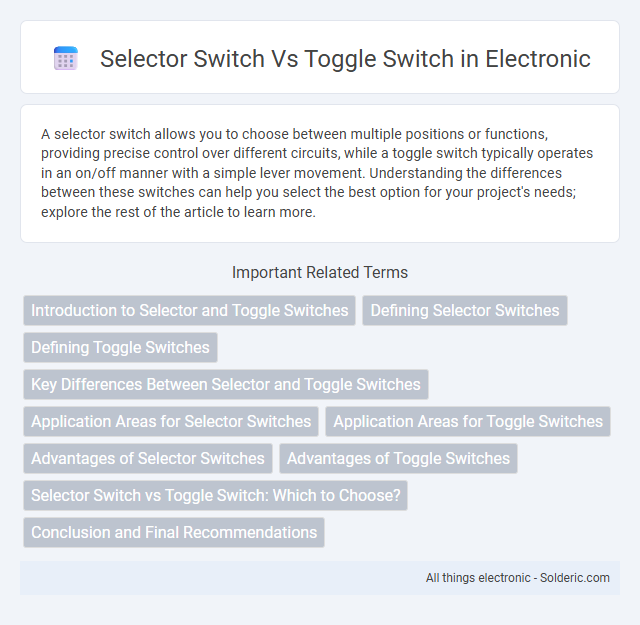A selector switch allows you to choose between multiple positions or functions, providing precise control over different circuits, while a toggle switch typically operates in an on/off manner with a simple lever movement. Understanding the differences between these switches can help you select the best option for your project's needs; explore the rest of the article to learn more.
Comparison Table
| Feature | Selector Switch | Toggle Switch |
|---|---|---|
| Functionality | Allows selection between multiple fixed positions or modes | Simple ON/OFF or two-state control |
| Operation | Rotary or lever mechanism to select position | Flip lever or toggle action |
| Common Uses | Mode selection in machinery, equipment control panels | Power control, device activation/deactivation |
| Number of Positions | Multiple (3 or more) selectable positions | Two positions (ON/OFF) |
| Installation | Panel-mounted, often circular cutout | Panel or PCB mounted, small footprint |
| Visual Feedback | Position indicator or markings | Lever orientation indicates state |
| Typical Voltage Rating | Varies, common in low to medium voltage applications | Low voltage mostly; some industrial variants available |
Introduction to Selector and Toggle Switches
Selector switches and toggle switches serve distinct functions in controlling electrical circuits, with selector switches offering multiple positions to select different circuit paths, while toggle switches typically provide a simple ON/OFF mechanism. The design of selector switches allows for precise control in applications requiring various operational modes, whereas toggle switches are favored for their straightforward, reliable switching action. Your choice between these switches depends on the complexity of control required and the specific application environment.
Defining Selector Switches
Selector switches are rotary or lever-operated devices designed to select a specific circuit or function from multiple options within an electrical system. They typically allow users to choose distinct operational modes, such as OFF, ON, or specific settings, by rotating or flipping the switch to the desired position. These switches provide precise control in applications like industrial machinery, enabling clear mode selection and safe operation.
Defining Toggle Switches
Toggle switches are mechanical devices that control an electrical circuit by flipping a lever back and forth to open or close the circuit. Unlike selector switches, which allow you to choose between multiple circuit options or settings, toggle switches typically offer two distinct states: on and off. Your application may benefit from toggle switches due to their simplicity, clear visual feedback, and ease of operation in controlling power flow.
Key Differences Between Selector and Toggle Switches
Selector switches allow users to choose between multiple positions or settings, making them ideal for applications requiring precise control over various modes. Toggle switches operate primarily with two positions: on and off, offering straightforward functionality for simple circuits. The key difference lies in the selector switch's ability to handle several states, while toggle switches provide binary control, influencing their suitability in complex versus basic electrical systems.
Application Areas for Selector Switches
Selector switches are primarily used in industrial control panels, machinery operation interfaces, and automation systems where multiple operational modes or settings are required. They enable precise selection between functions such as start/stop, speed control, and machine modes, enhancing operational safety and efficiency. Common applications include manufacturing plants, HVAC systems, and motor control centers where reliable mode switching is critical.
Application Areas for Toggle Switches
Toggle switches are widely used in automotive dashboards, industrial machinery, and household appliances due to their ease of operation and clear on/off positions. Their robust design makes them suitable for environments requiring frequent switching and tactile feedback. Common applications include light controls, power tools, and audio equipment where durability and quick access are essential.
Advantages of Selector Switches
Selector switches offer precise control by enabling users to choose specific functions or modes on a device, enhancing operational flexibility. Their clear visual indication reduces the risk of errors, improving safety in industrial and electrical applications. Durable construction ensures long-lasting performance even in harsh environments, making them ideal for heavy-duty machinery and control panels.
Advantages of Toggle Switches
Toggle switches provide reliable, easy-to-use on/off control with a clear physical indication of the switch position, enhancing user confidence in operation. Their robust design ensures durability in harsh environments, making them suitable for industrial and automotive applications. Toggle switches also allow quick, simple manual operation, reducing the risk of accidental activation or confusion compared to multi-position selector switches.
Selector Switch vs Toggle Switch: Which to Choose?
Selector switches offer multiple position options for precise control, making them ideal for complex machinery settings, while toggle switches provide simple on/off functionality suited for straightforward applications. Your choice depends on the required level of control and the specific application environment, with selector switches favored in industrial equipment and toggle switches common in residential or basic electronics. Consider the number of positions, ease of use, and durability when deciding between these two switch types.
Conclusion and Final Recommendations
Selector switches provide precise control for multi-position settings, making them ideal for applications requiring distinct operational modes. Toggle switches offer simplicity and ease of use, best suited for binary on/off functions with quick manual operation. Choose selector switches for complex control needs and toggle switches for straightforward, fast switching tasks.
Selector switch vs Toggle switch Infographic

 solderic.com
solderic.com